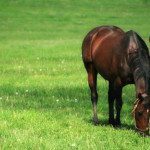Pre-Breeding Examination
If you are thinking of breeding from your mare, it is vital to ensure she is suitable for the purpose and thus it is important to check her general health status, whether she is physically capable of breeding and whether she is free from venereally-transmitted diseases such as Contagious Equine Metritis (CEM) and Equine Viral Arteritis (EVA). All mares, whether they are to be covered naturally or by AI, should have a pre-breeding examination. Ideally this should be performed when the mare is in the transitional phase (early oestrous) or cycling normally, i.e. from about February onwards. A thorough pre-breeding check can help to optimise the successful breeding of your mare.
1) Reproductive history
It is important to know if the mare has ever been bred from before and, if so, how successful the breeding attempts were and if there were any problems. Important information would include the number of foals the mare has already bred (and whether these were born alive or dead and if the foals suffered any problems early in life), details of the mare’s oestrous cycle (including length and duration of signs), previous breeding examinations and any investigations and/or treatment for subfertility.
It is important to consider the age of your mare; fertility declines when mares reach about 11 years old although, if a mare has foaled earlier in life, fertility is usually retained into the mid to late teens. Present use, body condition, previous/current health problems, injuries, vaccination history and whether the mare is currently receiving any medication are all important considerations too.
2) Physical condition and breeding conformation
The mare should be checked to see how anatomically suitable she is for breeding. Any inherited traits, e.g. parrot mouth, should be carefully evaluated as foals bred from mares with these disorders may inherit the same problem. The mare’s external genitalia should be checked; older mares are susceptible to sinking of the anus which can compromise the anatomical barriers sealing the uterus, resulting in air and faeces being sucked into the vagina, reducing fertility. This type of conformation fault can, however, be corrected with a minor surgical procedure (a Caslick’s operation) performed under standing sedation and local anaesthesia.
3) Screening for venereal diseases
In the UK, the most important diseases to screen for are the bacteria causing Contagious Equine Metritis (CEM), i.e. Taylorella equigenitalis, Klebsiella pneumoniae and Pseudomonas aeruginosa, and the virus causing Equine Viral Arteritis (EVA). CEM can be detected by a vet taking a clitoral swab at any stage of the mare’s cycle and sending the swab to an approved laboratory. If the results are negative then breeding can be allowed to proceed but if results are positive the mare must be treated, re-tested and declared free from infection before breeding can occur. EVA can be detected by taking a blood sample and sending it to an approved laboratory. CEM and EVA can have devastating consequences, including abortion, disruption of breeding and financial loss; for these reasons, these diseases are notifiable by law.
Some studs may require additional tests, e.g. screening for Strangles, before mares are allowed to go to stud. It is important that you check with the stud regarding their specific requirements and allow plenty of time for the tests to be performed before the mare is due to go to stud.
The Horserace Betting Levy Board produces annual “Codes of “Practice” with regard to recommendations for prevention and control of these diseases; a copy of this is available online at www.hblb.org.uk.
4) Vaginal examination using a speculum
A vaginal examination allows the vet to examine the cervix to make sure it is functioning correctly. The cervix acts as the final physical barrier between the uterus and the external environment; any damage to the cervix can result in the formation of scar tissue which can prevent the cervix from functioning properly, resulting in fluid accumulation in the uterus, thus reducing fertility.
5) Manual vaginal and cervical examination
6) Rectal palpation of reproductive tract
7) Ultrasound examination of reproductive tract
This allows the vet to assess whether the ovaries are cycling properly and also allows evaluation of the uterus for the presence of cysts and/or fluid accumulation, both of which can negatively affect fertility.
8) Other tests
Other examinations, e.g. endometrial swabs, may also be performed at the vet’s discretion depending on the mare’s health and reproductive history.
For further information or to discuss your mare’s specific requirements, please contact the practice or speak to Nikki Pursey MRCVS.


